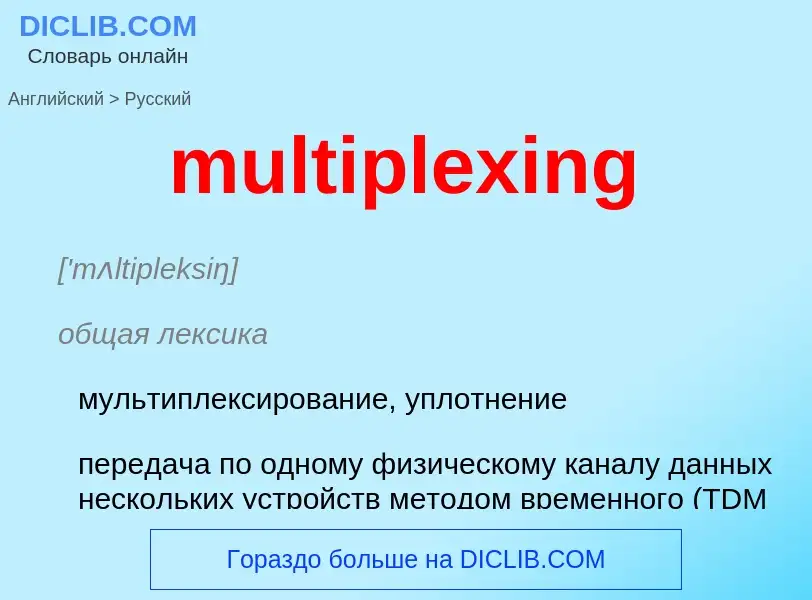Translation and analysis of words by ChatGPT artificial intelligence
On this page you can get a detailed analysis of a word or phrase, produced by the best artificial intelligence technology to date:
- how the word is used
- frequency of use
- it is used more often in oral or written speech
- word translation options
- usage examples (several phrases with translation)
- etymology
multiplexing - translation to russian
['mʌltipleksiŋ]
общая лексика
мультиплексирование, уплотнение
передача по одному физическому каналу данных нескольких устройств методом временного (TDM 2)) или частотного (FDM) его разделения на подканалы
мультиплексная передача
уплотнение
уплотнение линии связи
телефония, телеграфия
многократность
связь
разделение каналов
существительное
общая лексика
уплотнение каналов связи
многоканальная передача (информации)
мультиплексирование
общая лексика
демультиплексирование, разуплотнение канала связи
выделение сигналов отдельных каналов из входного потока сигналов и передача их соответствующим устройствам
сейсмология
демультиплексирование
общая лексика
раскоммутация
разборка соединения
Definition
Wikipedia
In telecommunications and computer networking, multiplexing (sometimes contracted to muxing) is a method by which multiple analog or digital signals are combined into one signal over a shared medium. The aim is to share a scarce resource - a physical transmission medium. For example, in telecommunications, several telephone calls may be carried using one wire. Multiplexing originated in telegraphy in the 1870s, and is now widely applied in communications. In telephony, George Owen Squier is credited with the development of telephone carrier multiplexing in 1910.
The multiplexed signal is transmitted over a communication channel such as a cable. The multiplexing divides the capacity of the communication channel into several logical channels, one for each message signal or data stream to be transferred. A reverse process, known as demultiplexing, extracts the original channels on the receiver end.
A device that performs the multiplexing is called a multiplexer (MUX), and a device that performs the reverse process is called a demultiplexer (DEMUX or DMX).
Inverse multiplexing (IMUX) has the opposite aim as multiplexing, namely to break one data stream into several streams, transfer them simultaneously over several communication channels, and recreate the original data stream.
In computing, I/O multiplexing can also be used to refer to the concept of processing multiple input/output events from a single event loop, with system calls like poll and select (Unix).


